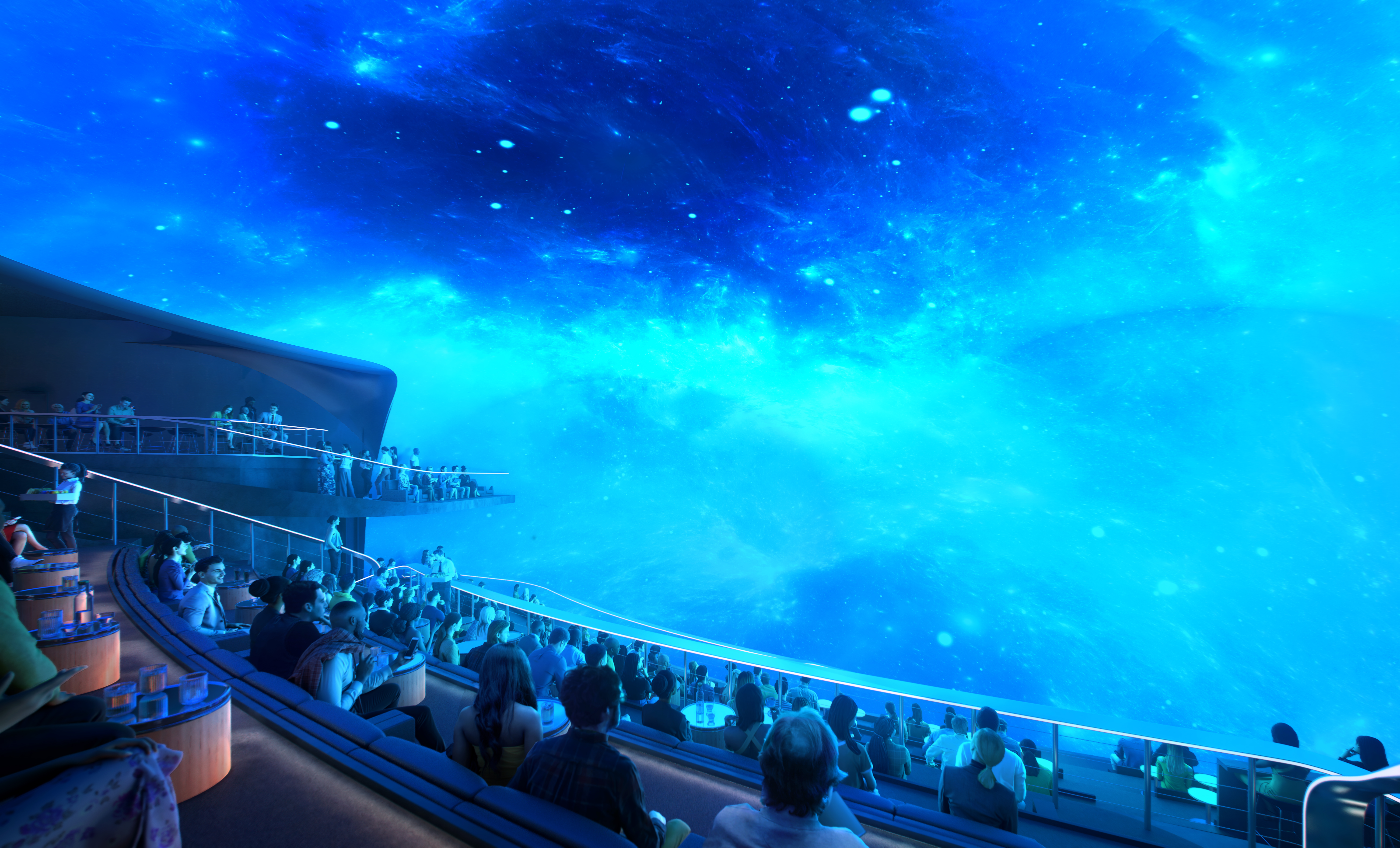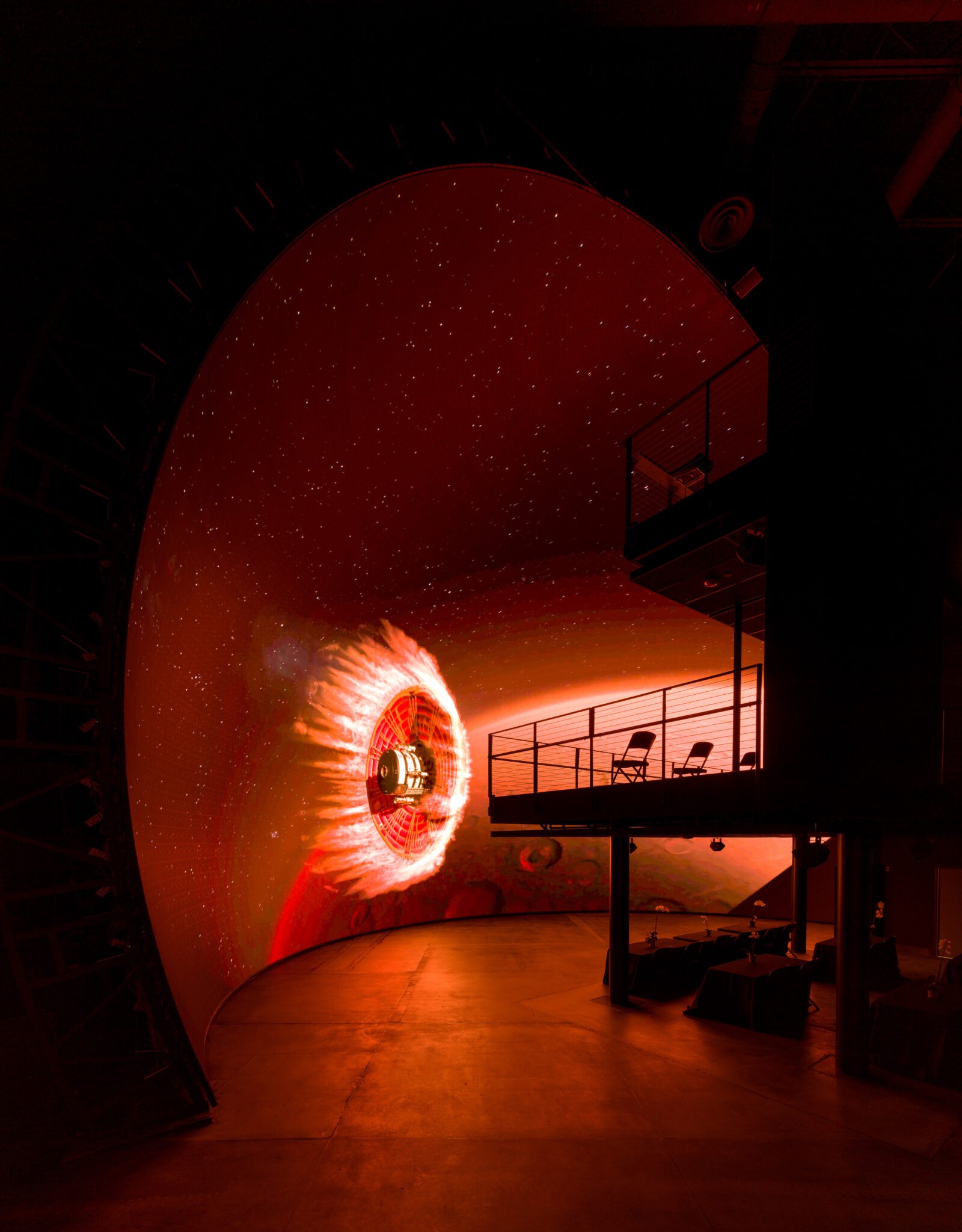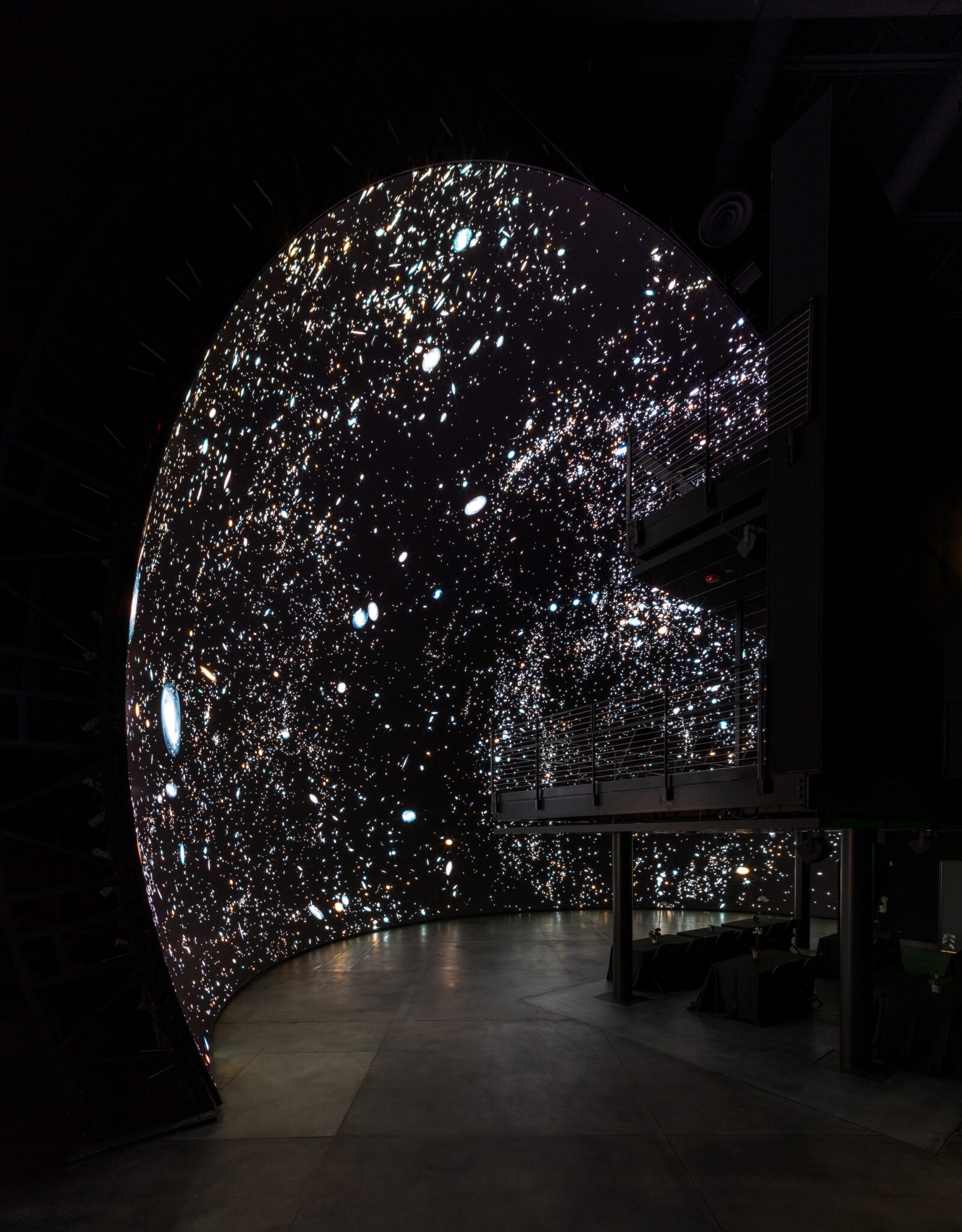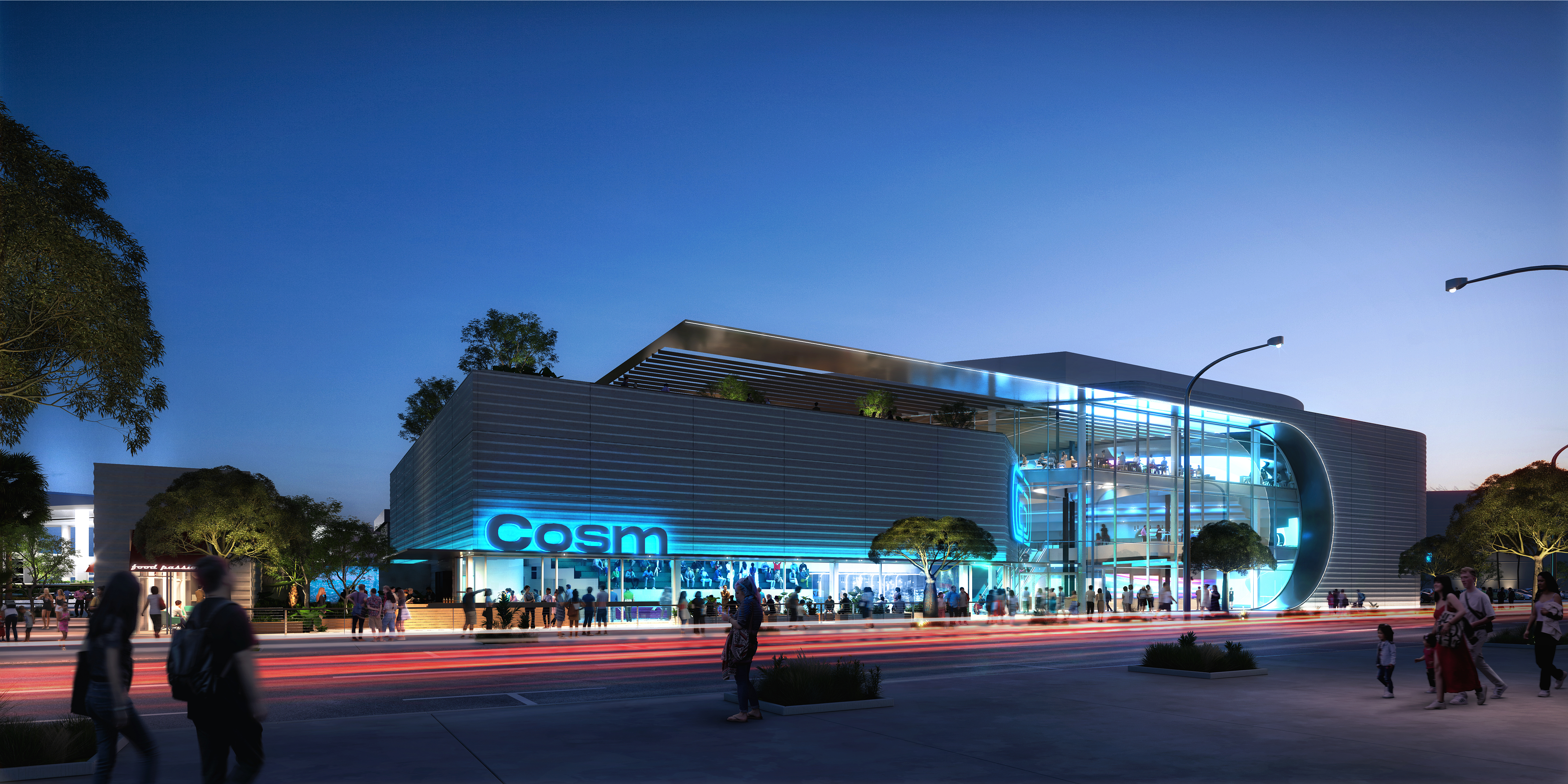LED has arrived in the dome, and Cosm’s pioneering CosmX Display and CosmX Engine are disrupting the media-based attractions space
Pack your bags, you’re going to Salt Lake City
Cosm formally emerged as a company in January 2021 following Mirasol Capital’s acquisitions in 2020 of two leading innovators in the planetarium and domed projection industry (Evans & Sutherland [E&S] and Spitz, Inc.) and LiveLike VR (now Cosm Immersive), a top immersive production company in sports and entertainment.
With this potent mix – proprietary leading-edge technologies, digital assets, market goodwill and a top engineering team and brain trust – Cosm set forth to serve its combined companies’ traditional markets while moving into the future. It addresses three verticals: sports and entertainment, science and education, and theme parks and attractions.
The new Cosm Experience Center at the company’s Salt Lake City headquarters showcases Cosm’s premium turnkey product: the CosmX Display (also known as the DomeX), and CosmX Engine. This sophisticated hardware and software package features an LED digital dome and real-time rendering for immersive, media-based experiences.
The successful application of LED display technology to the dome is a technical milestone – a pinnacle achievement that has brought a dramatic leap in visual quality, contrast and brightness, beyond what projection can deliver. While Cosm still offers projection solutions as well, the LED dome has set a new standard in the industry for premium experience.
CosmX Display is the shining star at the heart of the company’s bid for a bigger share of the attractions space, an initiative confidently led by CEO Jeb Terry and his team. To stoke this initiative, the company brought Doug Pagel onto the team in 2021, as Director of Worldwide Sales, Theme Parks and Attractions. Pagel is a business development specialist with more than a decade in the attractions sector.
The Cosm crew wants attraction operators, developers, integrators, creatives and other potential partners to visit the Cosm Experience Center for a first-hand demo, and to meet with them at the IAAPA Expo in Europe in September 2022 and Orlando in November 2022.
A new Cosm showcase is coming to California next year as well. The company is developing its first public venue, set to open in 2023 in Los Angeles, featuring the CosmX system in all its glory as part of the Hollywood Park retail district. The venue will include a 26.6-meter (87-foot) diameter LED dome in a 65,000 total square feet facility that can hold up to 1,700 guests. Programming at the venue will include live sports and entertainment, experiential events and IP-based content, immersive art, music, and more.
“Cosm comes from combining cosmos and coliseum,” says Jeb Terry, Jr., CEO and President of Cosm, explaining the origin of the company name and the business vision. “Experience and fandom in general apply across this, whether in sports, science, entertainment or music.” Terry’s background is a blend of sports and tech. He was an NFL offensive lineman with the Tampa Bay Buccaneers and the San Francisco 49ers. In 2008 he became a tech entrepreneur and digital media executive focused on interactive and emerging technologies. “Our job at Cosm is to make sure we invest in our technology and our team to deliver the best experience ever.”
A history in attractions
Specialty theaters are defined more by content than technology.
Planetariums and science centers have custom immersive theaters that take visitors on storytelling journeys into space, nature and science; theme parks and attractions have motion rides, dark rides, flying theaters and 4D theaters that plunge guests into entertainment narratives.
The delivery systems are comparable in their equipment and complexity, and the market segments converge. E&S/Spitz (now both Cosm companies), longstanding market leaders in planetariums and specialty cinema, already have a long history in attractions, primarily due to demand for their custom screens and displays. The Nanoseam screen, introduced by Spitz in 2008, is a key display component of some of the most innovative and celebrated media-based attractions in the world. E&S systems have also been customized for exhibits in a number of world’s fair pavilions over the years.
“We have always excelled in the attractions market with our domes and other displays and structures,” says Kirk Johnson, Executive VP and GM of E&S, a veteran of the planetarium and giant screen industry with the company since 1990. “Our work in engineering the world’s best immersive LED dome display is truly groundbreaking. There is no question that what we’ve created is the future of shared immersive experiences.”
“Cosm is a global technology company with a 75-year history pioneering the shared reality space. Our technology is used by the world’s largest entertainment brands to create mind-blowing immersive experiences for millions of guests,” says Doug Pagel.
How CosmX evolved
E&S was a pioneer in computer graphics for the simulation industry from the early, emergent days, and built on this to become a pioneer in digital planetariums with its widely adopted Digistar star projection system, introduced in 1983. Today, nearly all planetariums have fulldome systems: sophisticated, digital cinema hardware and software packages (usually with multiple projectors) that include digital video playback and real-time image generation for starfields and more. Fulldome systems opened up vast new possibilities for content and guest experience. The first permanent fulldome installation was the E&S StarRider in 1998 at Chicago’s Adler Planetarium.
Fulldome continued to improve, and essentially transformed planetariums into high-end, digital dome cinemas with real-time interactivity. Top-of-the-line E&S systems led the way in replacing many aging 70mm film dome systems.
The image generation technology that enabled planetariums to host real-time journeys through digital worlds revolutionized their visitor experience; today, the same technology – more commonly known as a gaming engine – is also harnessed for real-time experiences encountered in dark rides and attractions. There is considerable, ongoing collaboration and crossover with sports, broadcast, VR and gaming.
It must be re-emphasized that until now, these systems have relied on projection (though often very high-quality projection). CosmX with its LED display (and myriad other features) represents a vivid, game-changing new option.
Cosm Chief Product and Technology Officer Devin Poolman, a digital platform specialist with a background in sports broadcast, says, “We’re very excited about the opportunities for real-time, interactive experiences that can be different every time. A big part of this is making sure that the power and creative potential of the real-time engine are something that can be used by everyone in our customer community. This is one of the areas in which CosmX is truly transformational.”
The CosmX components
The CosmX Display at the Cosm Experience Center takes the form of an LED 20-meter diameter truncated dome, vertically positioned to allow viewers full, floor-to-ceiling immersion.
It touts over 5,000 square feet of display, with 8K resolution, including 29.5 million pixels, stereoscopic 3D capable and high-frame-rate capable up to 120 fps. The Cosm proprietary, LED display is a perforated screen made up of a series of panels that can be swapped out when needed.
The showcase includes a 30.4 speaker spatial audio system. According to Poolman, there are 16 speakers behind the dome. There is also an audio spatializer (an optional item) that enables pinpointing sound and mapping sound inputs. The audio is based on Dante and works turnkey with a variety of existing audio formats. It can be auto-tuned by the CosmX Engine or manually by the operator.
“Together, the CosmX Display and CosmX Engine provide everything to drive the dome and displays – from structural design to the actual frames that hang the panels, to the system software and hardware,” says Poolman.
One of the benefits that Cosm’s planetarium customers have enjoyed for a number of years is a repository of show resources in the cloud. Attraction operators and media producers can turn this capability to account in a variety of ways, for instance to create libraries for regular and special programming, to draw on content created by users around the world, or to store digital assets.
What Poolman terms “the best stereoscopic 3D in the business” is effectively delivered thanks to a combination of factors: a system configured for 120 fps frame rate (divide by two for 3D, 60 fps for each eye), active shutter glasses, and the overall brightness and contrast of the system with E&S patented technology. It can be combined with real-time content for a live immersive experience that guests can enjoy at the Cosm Experience Center. “We have overcome the major challenges and faults of projection-based 3D,” says Poolman.
In the context of installation and integration, how does it fit into a venue or complex? “CosmX is readily compatible with external show control systems,” says Poolman. “In terms of other building systems, we provide HVAC and power requirement specifications and it is typically very easy to fit into a project, with a straightforward install.” What if you haven’t updated in a long time? “We tackled just such a situation with the Cosm Experience Center,” he says. “Other than some electrical and HVAC updates it was pretty turnkey.”
Content: It’s Unreal
After visiting Cosm with a delegation from the Giant Screen Cinema Association in 2021, noted planetarian Ian McLennan called it “the first quantum leap I have seen in this industry.” But he wasn’t only referring to visual quality and capability – he was also talking about leveraging content.
The CosmX Engine is able to convert and optimize a dizzying range of content more or less automatically, with utter simplicity for easy viewing on the CosmX Display. It was purposefully designed to maximize the ability of creatives and operators to leverage its real-time capabilities and gaming tie-ins in as many ways as possible. As Poolman says, “Building on 40 years of success with Digistar, which is the 3D engine underlying the system, the CosmX Engine supports working with new types of media, including third-party content platforms such as Unreal Engine that have revolutionized the virtual production space.”
“We have added features to the CosmX Engine that allow content to be displayed from virtually any source, including real-time, Giant Screen video, VR 360, Unreal and many other sources,” says Johnson. “This provides unrivaled flexibility for our customers to create and display anything they want or need.”
The idea here is that content can truly rule. “With these compatibilities, you’re not limited to things created specifically for Digistar or our CosmX Engine – you can develop any content for immersive scale environments and realize it with the system’s best-in-class rendering engines,” says Poolman. “You can add inputs for different levels of immersive experience – blaster devices that can blow things up on the screen, mobile experiences where guests use their own devices…. Motion capture systems, trackers or other props can be part of the experience. We’ve demonstrated this to many visitors at the Cosm Experience Center.”
But how? “The CosmX Engine can resize, move back, move forward, etc. – giving complete control over how something is laid out in a 3D world,” says Poolman. “This is true for all images, video and content made for immersive viewing – they might have varying ranges of field of view, but you can control how they are mapped on screen down to the pixel, zoom in, and shift around.” And, he explains, the system will adapt to the display configuration, meaning it doesn’t have to be a perfect dome. Poolman says, “That includes custom displays of varying geometries, toroidal screens, slice-of-sphere, etc. It can adapt regardless, even handle real-time projection mapping. For most content formats it is drag-and-drop. It will ingest and display out-of-the-box, but you can jump in and customize.”
“The CosmX Display alleviates the limitations of previous projector-based domes and curved displays,” says Johnson. “It provides a blank canvas for producers to be completely creative and translate their ideas in ways previously not possible. They aren’t just limited to cameras or video. So many tools and formats are available now for producers to create whatever they can imagine. Producers may find that they need to up-level their techniques to make the most of it. At the same time, we can make their existing content look better than it has ever looked before. The CosmX Engine gives content producers much more in the way of flexibility and tools than anything previously available.”
Helping to make things really pop is the unprecedented level of contrast. This system provides the ability to have the brightest lights and the blackest black – Cosm black, absolutely pitch black, even in a dome, which previously was not possible,” says Poolman. “We stand behind that.”
Transforming attractions
Pagel reports a high level of interest among theme parks, stand- alone attractions, resorts and attraction suppliers. “We have seen strong enthusiasm in a variety of use cases and markets where Cosm provides a ‘Suspension of Disbelief ’ to the guest,” he says, and named specific examples:
Media based flying rides: “The CosmX Display does not have line-of-sight restrictions that projection systems may have, allowing for a deeper immersion of the guest within the display especially from the peripheral viewpoint,” says Pagel. “And because of the brightness and high resolution of the display, our CosmX system provides a high sense of perceived motion on its own which is then complemented by the motion and SFX features of the attraction.”
For dark rides: “The CosmX Display visually expands the space in the room, providing a greater impact for the guest. Guests will be convinced that they are exactly where the content takes them. In addition, having CosmX Engine seamlessly integrated with Unreal and Unity game engines unlocks interactive tracking capabilities for complete creative control and maximum audience participation.”
Pagel also sees the technology being incorporated for some, less traditional entertainment experiences that are growing in popularity and may exist as standalone venues, pop-ups or within a larger complex. He cited immersive dining, virtual aquariums, dance clubs, virtual tourism, live event programming, cinema, performance arts, and more.
“You can talk about 150 foot-lamberts of brightness, 8K or higher resolution, orders of magnitude higher contrast… But until you sit inside the display and experience it, you don’t fully understand how transformative and emotional the experience can be,” says Johnson, in a reminder that ultimately, success is defined by a great guest experience.
And Terry, for his part, reminds us that achieving those goals is ultimately all about people. Having successfully launched Cosm in the throes of the early pandemic, there’s probably nothing that could put a dent in Terry’s enthusiasm and energy as he continues to build his team and pursue his vision. “What has made these companies great is not just the ideas but the people, the history, the clients. There was a lot of undocumented expertise in the energy of these companies, with so many team members of long standing. This amazing group of people helped build the foundation. It was our goal and our job to listen and learn with open ears and open eyes, to gain an understanding beyond the numbers, learn what makes our clients happy, cultivate what’s great. That’s been the core. The foundation of excellence is here.”
Artist rendering of the exterior of Cosm’s first public-facing venue in Los Angeles to open in 2023
But how? “The CosmX Engine can resize, move back, move forward, etc. – giving complete control over how something is laid out in a 3D world,” says Poolman. “This is true for all images, video and content made for immersive viewing – they might have varying ranges of field of view, but you can control how they are mapped on screen down to the pixel, zoom in, and shift around.” And, he explains, the system will adapt to the display configuration, meaning it doesn’t have to be a perfect dome. Poolman says, “That includes custom displays of varying geometries, toroidal screens, slice-of-sphere, etc. It can adapt regardless, even handle real-time projection mapping. For most content formats it is drag-and-drop. It will ingest and display out-of-the-box, but you can jump in and customize.”
“The CosmX Display alleviates the limitations of previous projector-based domes and curved displays,” says Johnson. “It provides a blank canvas for producers to be completely creative and translate their ideas in ways previously not possible. They aren’t just limited to cameras or video. So many tools and formats are available now for producers to create whatever they can imagine. Producers may find that they need to up-level their techniques to make the most of it. At the same time, we can make their existing content look better than it has ever looked before. The CosmX Engine gives content producers much more in the way of flexibility and tools than anything previously available.”
Helping to make things really pop is the unprecedented level of contrast. This system provides the ability to have the brightest lights and the blackest black – Cosm black, absolutely pitch black, even in a dome, which previously was not possible,” says Poolman. “We stand behind that.”
Transforming attractions
Pagel reports a high level of interest among theme parks, stand- alone attractions, resorts and attraction suppliers. “We have seen strong enthusiasm in a variety of use cases and markets where Cosm provides a ‘Suspension of Disbelief ’ to the guest,” he says, and named specific examples:
Media based flying rides: “The CosmX Display does not have line-of-sight restrictions that projection systems may have, allowing for a deeper immersion of the guest within the display especially from the peripheral viewpoint,” says Pagel. “And because of the brightness and high resolution of the display, our CosmX system provides a high sense of perceived motion on its own which is then complemented by the motion and SFX features of the attraction.”
For dark rides: “The CosmX Display visually expands the space in the room, providing a greater impact for the guest. Guests will be convinced that they are exactly where the content takes them. In addition, having CosmX Engine seamlessly integrated with Unreal and Unity game engines unlocks interactive tracking capabilities for complete creative control and maximum audience participation.”
Pagel also sees the technology being incorporated for some, less traditional entertainment experiences that are growing in popularity and may exist as standalone venues, pop-ups or within a larger complex. He cited immersive dining, virtual aquariums, dance clubs, virtual tourism, live event programming, cinema, performance arts, and more.
“You can talk about 150 foot-lamberts of brightness, 8K or higher resolution, orders of magnitude higher contrast… But until you sit inside the display and experience it, you don’t fully understand how transformative and emotional the experience can be,” says Johnson, in a reminder that ultimately, success is defined by a great guest experience.
And Terry, for his part, reminds us that achieving those goals is ultimately all about people. Having successfully launched Cosm in the throes of the early pandemic, there’s probably nothing that could put a dent in Terry’s enthusiasm and energy as he continues to build his team and pursue his vision. “What has made these companies great is not just the ideas but the people, the history, the clients. There was a lot of undocumented expertise in the energy of these companies, with so many team members of long standing. This amazing group of people helped build the foundation. It was our goal and our job to listen and learn with open ears and open eyes, to gain an understanding beyond the numbers, learn what makes our clients happy, cultivate what’s great. That’s been the core. The foundation of excellence is here.”




